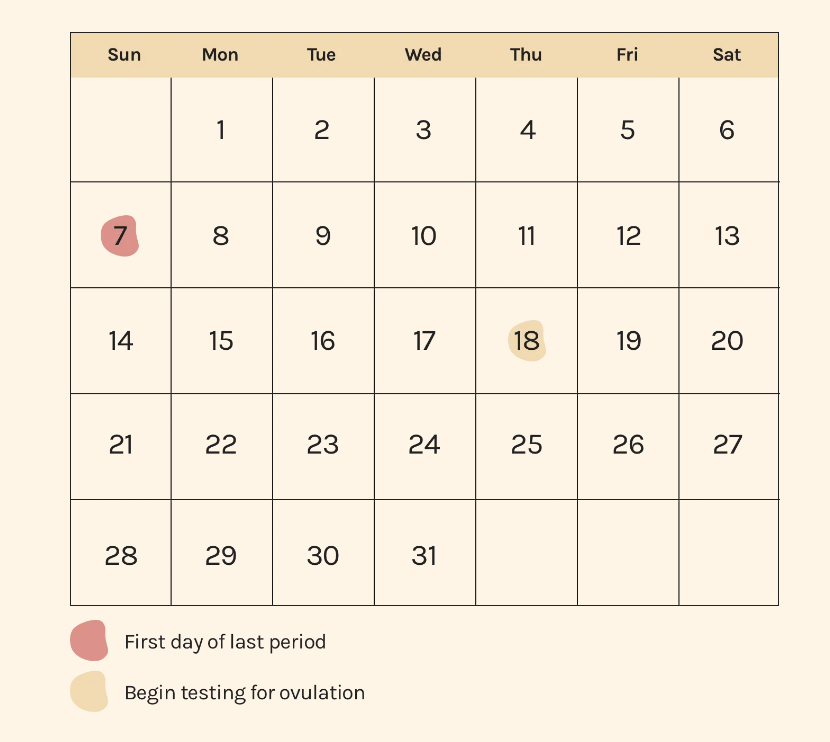Will I be able to track my ovulation at home?

There is so much going on in our bodies at once, sometimes it’s hard to keep up. Getting on top of your cycle might seem intimidating, but is so simple once you have all the information. The easiest way to track your cycle is by taking ovulation tests. The good news? It’s simple, informative, and you don’t even have to leave your house.
How do ovulation tests work?
Ovulation tests show when you’re ovulating (AKA when you’re most fertile and likely to get pregnant). But what is ovulation? Like menstruation, ovulation happens once a month for anywhere from 12-48 hours. Of the four phases of your menstrual cycle (menstrual, follicular, ovulation, and luteal), ovulation is the shortest. During ovulation, your body releases the Luteinizing Hormone (LH) which sends a signal from your brain to your ovaries that they should release eggs. This happens once a menstrual cycle.
In the days right before ovulation, your body will produce a surge in luteinizing hormone (LH). An ovulation test detects the LH surge in your urine, showing a positive result if your LH is surging and a negative result if it is not surging.If you do get a positive ovulation test results, you’re likely to ovulate within the next 24-48 hours. These next 24-48 hours are when you’re most fertile and most likely to get pregnant.
Shop the article
If you have no idea when in your cycle you may be ovulating, test daily to be sure you don’t miss your LH surge. Ovulation only lasts between 12 and 24 hours, so knowing your ovulation day is key to understanding when you can and cannot get pregnant in your menstrual cycle.
To figure out when to test in relation to your cycle, it’s best to start tracking when you get your period (we recommend a period tracking app or an old-fashioned calendar!) This will help you understand your cycle length, which is the number of days from the last day of your last period to the first day of your most recent period. Once you determine your cycle length, take a test 19 days before the start of your period. Ovulation typically happens on the 15th day of your menstrual cycle, but differs from person to person. You can also check out the below chart to decipher your cycle!
![]()

The best time of the day to take an ovulation test is first thing in the morning before you’ve had anything to drink. In the morning, your urine has not been diluted by water and is more concentrated, making it easier for the ovulation test to pick-up levels of LH in your urine. Testing around the same time every day will provide more accurate results as well.
How to read a ovulation test
Most ovulation tests have two windows: a control window and a test window. If only the control line appears or the test line is lighter than the control line, the test result is negative, meaning that no LH surge is detected and you will not ovulate in the next 24-48 hours. If both the test line and control line are visible and the test line is darker than or equal to the control line, the test result is positive, meaning that a LH surge is detected and ovulation will likely happen in the next 24-48 hours. If there is no distinct pink-purple colored line visible both in the test area and control area the test is invalid and you should retake the test.
Incorrect ovulation test results can be attributed to a number of things. Taking a test after drinking a lot of water can lead to a false negative result as the water in your urine dilutes the LH and makes it hard for the test to detect. Certain conditions, like polycystic ovary syndrome (PCOS), cause high enough LH levels to be detected by a test all the time, even if ovulation is not happening. If the result lines of your test are faint, be sure to read the instructions and take another test.
What do ovulation test results mean in relation to fertility? If you’re trying to have a baby, you’re most likely to get pregnant if you plan sex 24 to 36 hours after a positive ovulation test. Getting pregnant when you’re not ovulating is possible but extremely unlikely. After ovulation, your body releases the progesterone hormone which prepares your body for your next period, indicating that you’re not pregnant. Getting pregnant involves the release of a mature egg, which only happens during ovulation. After ovulation, the mature egg is no longer available and can’t be fertilized.
How accurate are ovulation tests?
Most at-home ovulation tests, like Winx Health (formerly known as Stix), are over 99% accurate if used correctly. That being said, ovulation tests don’t actually test for ovulation, they test for the LH hormone which surges a day or two before ovulation happens.
There are several different types of ovulation tests, but they all generally work the same way. Strip-based tests are small strips that you dip in a cup of your urine (instead of peeing directly onto it) that detect LH and show your results depending on how many lines appear on the strip. Midstream tests, like Winx Health, use the same strips as strip-based tests, but packaged in plastic that you hold while you urinate onto the strip. There are also saliva based ovulation tests that test your saliva daily to detect patterns that predict ovulation. Saliva tests are the least accurate of the three types of ovulation tests but can still be an effective way to predict ovulation.
When considering which kind of ovulation test to buy, make sure you buy from a brand you trust. At Winx Health, we’ll ship 7 ovulation tests straight to your door on a one-time or recurring basis in super discreet packaging and easy to read instructions. Because ovulation testing should be easy.
Keep Reading

I don't want to get pregnant under this administration, what do I do?
Mar 19

Six weeks is too soon: the reality of abortion bans
Feb 24

I hate my vagina: the labiaplasty epidemic
Feb 18








